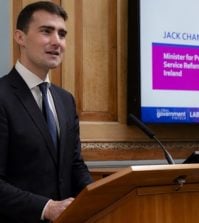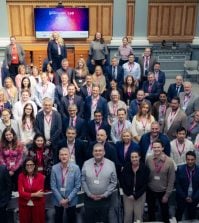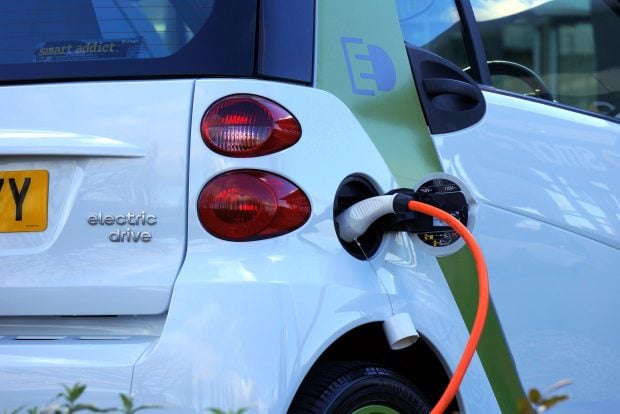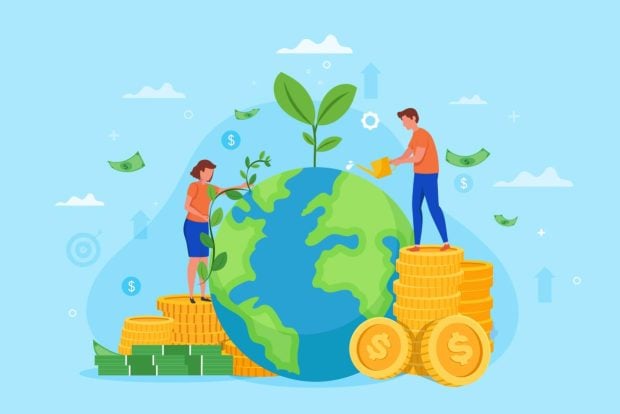Investing energy: what’s needed to fund the transition to a green economy?

At a Global Government Forum webinar, Mia Hunt heard panellists explore the issues around shaping public investments for a net zero world, touching on the need to consider social as well as environmental and economic impacts, private sector investment in public infrastructure projects, and the accompanying goal of digital transformation
Despite the climate action commitments made by world leaders at COP26, we are expected to miss the Paris Agreement target of exceeding no more than two degrees global warming compared to pre-industrial levels. As Ipek Gencsu, senior research fellow, climate and sustainability at think tank ODI, said at the start of the webinar, the years between now and 2030 are going to be crucial if we are going to make the drastic change needed to turn things around.
The development of and government support for green initiatives, renewables and clean technologies, and adaptation and risk mitigation measures are “fantastic”, Gencsu said, “but what’s really needed is to decarbonise faster” and that means bringing an end to investment in fossil fuels.
In 2019 alone, governments’ provided US$468bn of subsidies for fossil fuel production and consumption whilst also investing in fossil fuels through state-owned enterprises, utility companies, and through export credit agencies that support businesses abroad.
“The recent energy price crisis shows how much we are at the mercy of fossil fuel price volatility,” Gencsu said. “When people’s gas bills increase, the government has to be there to cushion away some of that impact, but what they really must do is to try and support them with energy alternatives, and also increasing energy efficiency as much as possible through insulation and other kinds of investment.”
Of course, phasing out fossil fuels is easier said than done, particularly in emerging markets and low-income countries that rely on carbon emission-intensive industries for their economic development. The panellists agreed that equality must be a key consideration in any climate-related investment decisions.
Green investments enhance welfare – but not for all

As Mariano Moszoro, senior economist, fiscal affairs department at the IMF, pointed out, while green investments are welfare enhancing globally, they may not be welfare enhancing for certain countries due to the higher cost of transition.
He referred to the ‘Pareto efficiency’, a term in economics that refers to a situation where (in this context) no individual country can be better off without making at least one other country worse off. “With the transition, it will happen that the cake will be bigger, but some countries will have a smaller piece of that cake”. Therefore, he said, “we have to develop transfer schemes to compensate those countries for whom the transition will be more costly”, through grants and loans, for example.
Gencsu echoed Moszoro’s point about the transition to a green economy needing to be an international effort and noted a deal brokered at COP26 to support South Africa’s energy transition. “It was an international initiative launched by the UK, France and Germany, with support from the US and the EU, because they recognise that this is not a transition that South Africa can make on its own. More international initiatives on supporting the just transition are critical.”
It is important to think about countries that are having to balance the transition with their sustainable development goals on a case-by-case basis “looking at where a country is with regards to the options that are available to them, and the financing that will allow that to happen,” Gencsu added. As part of that, the workers and communities involved in the sectors that will need to be phased out would need to be supported “whether that’s early retirement or retraining and skills development”.
EU pledges to ‘do no significant harm’
Intertwined with the social impact of the transition to a green economy, there are ethical considerations too. One member of the webinar’s audience brought up the example of electric vehicles (EVs). Governments around the world are promoting the use of EVs and banning the sale of fossil fuel-burning vehicles to meet net zero commitments. But extracting the materials needed to make EV batteries involves controversial practices and often takes place in countries known for human rights abuses.

The ODI is currently working on assessing the inequality impacts of green policies. “Unfortunately, green doesn’t always mean everything will be good and easy – I think that’s the challenge,” said Gencsu. “There are issues and concerns around extractives in fossil fuel and mining that will continue to be the case in these technologies. We have to look at the broader sustainable development goals and broader objectives and balance the different considerations but absolutely, we can’t just say we can go green at the cost of humanitarian issues.”
It is an important and sticky issue for European Commission economist Cristiana Belu Manescu. In a bid to tackle it, the Commission applied the ‘do no significant harm’ (DNSH) principle to its Recovery and Resilience Facility (RRF) in February 2021. The RRF aims to mitigate the economic and social impact of the coronavirus pandemic and make European countries more sustainable, resilient, and better prepared for the challenges and opportunities of the green and digital transitions. Binding in the DNSH principle encourages member states to ensure that the investments they make do not harm any of the six environmental objectives of the EU Taxonomy Regulation, including climate change mitigation and adaptation.
Private sector investment in public works
The RRF is one example of a public funds framework whose primary purpose is to boost the post-pandemic economy whilst also focusing on green investment.
Michael Flynn, global infrastructure, transport and regional government sector leader at Deloitte – the webinar’s knowledge partner – highlighted that in past crises, boosting the economy has been heavily skewed towards investment in infrastructure. But unlike in the aftermath of past crises, “there is now a societal demand around climate and equality and so those demands need to be aligned with governments’ plans. There is a shift in objectives”.
Now, governments are looking at the environmental impact of infrastructure projects including within the supply chain, and focusing more intently on tech and digital.
Governments have put infrastructure packages together that total about US$5 trillion, Flynn said. He pointed to the EU Green Deal, the UK’s ‘levelling up’ agenda, and president Biden’s Build Back Better as examples. But the new environmental considerations come at a cost, adding – according to the OECD – nearly US$2bn to the planned projects. “The challenge now is, with governments having spent an awful lot of money on COVID, how do they make sure that they deliver against this? Even when the figure was US$5 trillion, only about half that could be supported by the public sector,” he said.

In his view, this is no bad thing because the financial services sector and investment managers are increasingly interested in investing in infrastructure projects that meet environmental criteria and are able to plug the funding gap. There is “great demand” for funding markets to get involved in properly structured climate-focused projects, “it just needs to be tapped,” he said.
One of the public servants watching the webinar asked whether there was an opportunity for pension funds and insurance companies to invest in flood defence projects, for example, as it is in their long-term interest to prevent future disasters.
According to Flynn, such companies are already investing in infrastructure projects, particularly in mature markets like the UK. Get the structure right, with support from the likes of the EU and World Bank, and “you can get more of these capital resources into these types of project,” he said.
Tying in with the digital transition
The European Commission estimates that up to €650bn (US$735bn) will be required annually up to 2030 to fund the green and digital transition. “Clearly, much of this funding will be provided by the private sector, but at the same time, public investment is going to play a key role,” Belu Manescu said.
In either case there will need to be a return, whether that be monetary or in the form of a stronger, more stable economy and lower carbon emissions. But as Moszoro had said earlier in the discussion, green investments don’t necessarily lead to long-term jobs growth. So what of digital transformation initiatives?
While digitalisation increases productivity, it isn’t yet clear whether it leads to lower emissions, Moszoro said. He gave an example: people may commute less in countries that have good digital infrastructure, lowering pollution from vehicles. But as a result, internal trade – such as “more pizza delivered to homes” – increases, as does the wider economy, which in turn produces more carbon. The results of IMF modelling in this area are ambiguous, he said. “What is, from an economic point of view, enhancing for growth may not necessarily be good for carbon emissions. Digitalisation is moving to another type of economy. We want to move there. But we have to think in parallel about how to keep emissions low.”

Flynn explained that Deloitte has been involved in projects where sensors have been installed across entire road networks, allowing authorities to assess the movement of traffic and make changes to smooth traffic flows. Embedding digital technology into road infrastructure “allows you to manage your entire traffic system with an emissions and an environmental focus… It’s starting to be done,” he said, “but there’s a long way to go”.
As for the EU, Belu Manescu referred again to the bloc’s RRF. Member states have allocated almost 40% of the spending in their plans to climate measures and more than 26% to the digital transition, exceeding the respective targets of 37% and 20%.
There are a number of other EU initiatives that aim to support digital infrastructure including plans to establish a digital market “so that’s definitely very high on the agenda”, Belu Manescu said.
Carbon capture vs renewable power generation
The conversation moved on to carbon capture technologies and whether they should be a consideration in addition to renewable power generation. Gencsu is dubious. Carbon capture technologies are in their infancy and very expensive, especially at the scale that would be needed, she said. “Ideally, in terms of risk, there should be more emphasis on renewable solutions, and of course, the one carbon capture technology that we can use at scale, which is trees. There is a lot of work to be done in terms of limiting deforestation and reforestation initiatives where we know the costs. [Carbon capture] is a little bit of a distraction and an excuse for the prolonging of fossil fuel sectors. Of course, we should explore all of the options in the longer term to make sure that we avoid climate disaster but we should not sway from the much more pragmatic and proven solutions of renewable technologies, the costs of which have come down dramatically in recent years.”
In all matters related to the green transition – managing the just transition; planning and funding infrastructure projects; digital transformation; promoting renewable energy; and considering alternatives such as carbon capture – there is a need to conduct impact risk assessments. And as one audience member asked, do civil servants around the world understand the cost of inaction as well as they do the cost of action?
“All of us need to understand it better. We shouldn’t just point the finger at civil servants,” Gencsu said. “These are very difficult calculations and also very frightening ones… we just don’t see the cost of and the risks associated with inaction.”
It would “make a lot of sense”, she said, for governments to support their civil servants to gain a better understanding of the cost of stranded assets and extreme weather events through training. “What we’re seeing is the physical impact and the implications of extreme weather events occurring more regularly, from floods to wildfires to tornadoes. There’s public awareness of this, and I think we have to follow through in terms of really mainstreaming these analyses into the decisions we’re making everyday.”
Such discussions about the green transition and the funding needed to support it can take a sombre tone because the need is great and the challenges many.
“The task is very challenging,” Belu Manescu said. “And in addition to all these trade-offs that we’ve been discussing on the technology side and on the funding side, I think one element that is very important and cannot be minimised is the social impact of this transition. The European Commission is very vocal about that and it’s something we need to emphasise. That’s partly why the change is so gradual because we have to make sure that the economic adjustment is as fair as possible. But that is not easy to do.”
Nevertheless, based partly on EU countries’ demonstration they are serious about the need for change by overachieving on the RRF targets and embracing the DNSH principle, she said she was optimistic that real change will happen. Because it must.
The Global Government Forum webinar ‘Shaping public investments for a net zero world’ was held on 25 January 2022, with the support of knowledge partner Deloitte. You can watch the 75-minute webinar via our dedicated event page.























